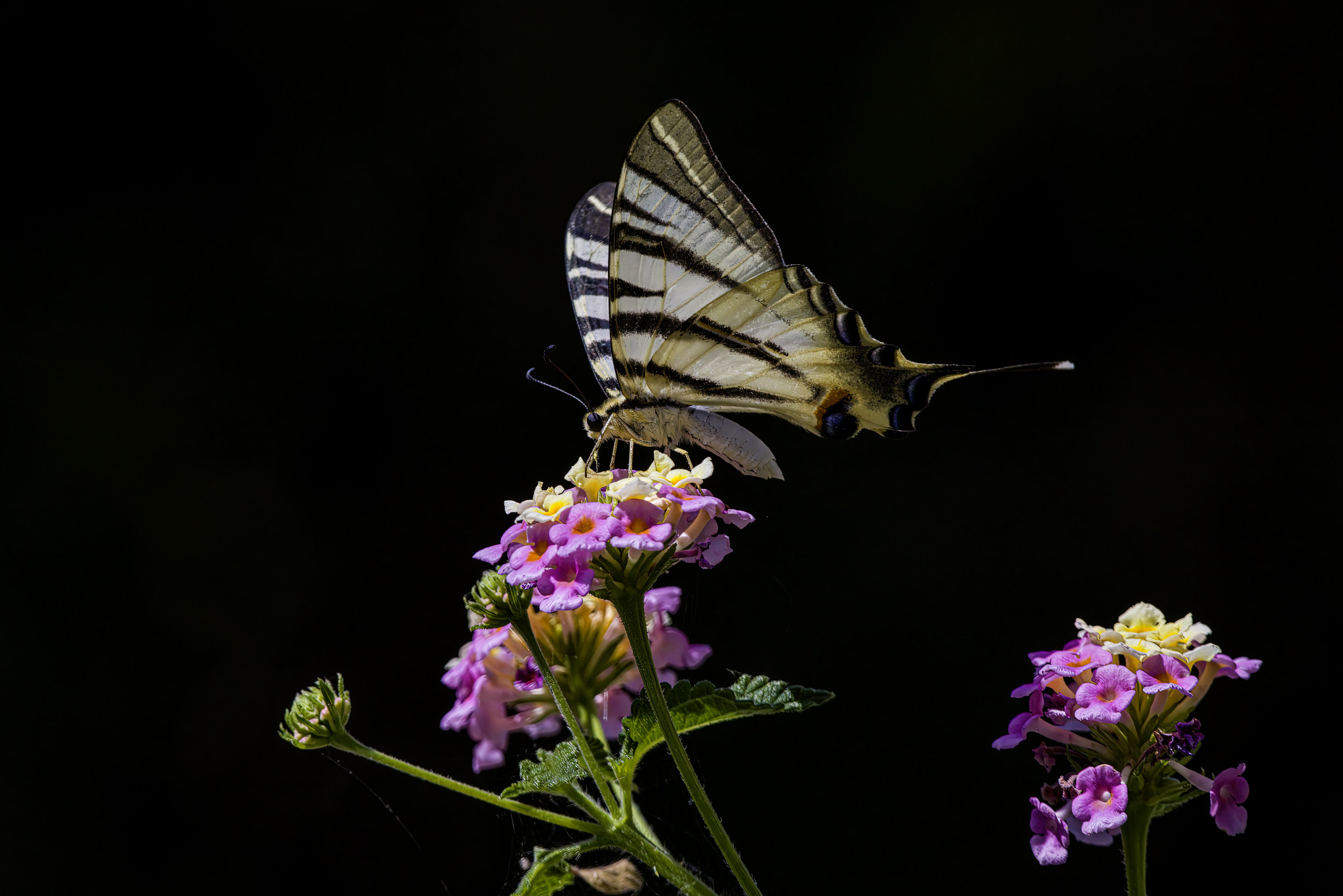The Scarce Swallowtail (Iphiclides podalirius) is a large, striking butterfly belonging to the family Papilionidae. Despite its name, the Scarce Swallowtail is not particularly rare in its range and is one of the most recognizable butterflies in Europe due to its elegant, elongated tails and bold black-and-white wing patterns. It can be found in a variety of habitats across southern Europe, North Africa, and parts of Asia.
Physical Description:
- Wingspan: The Scarce Swallowtail has a large wingspan, measuring between 60 to 90 mm (2.4 to 3.5 inches).
- Coloration:
- Forewings: Pale yellow to creamy white, marked with bold, black tiger-like stripes. The wings are pointed, and the black lines give it a zebra-like appearance.
- Hindwings: The hindwings are similarly pale with striking black markings and a beautiful blue lunule near the bottom. The hindwings feature characteristic swallowtail extensions or tails, which are long and tapering.
- Tails: The tails are black and elongated, enhancing the butterfly’s elegant look.
- Eyespots: The hindwings also have small orange eyespots near the tails, which are believed to help confuse predators by directing attacks away from the butterfly’s body.
- Body: The body is pale yellowish with dark stripes running longitudinally.
Sexual Dimorphism:
Males and females are quite similar in appearance, though females may be slightly larger and more robust. Both sexes share the same color patterns and markings.
Behavior:
- Flight: The Scarce Swallowtail is a strong, graceful flier and is known for its gliding flight. It can be seen soaring around open woodlands, hillsides, and sunny clearings.
- Feeding: Adults feed primarily on nectar from flowers such as thistles, clover, and various flowering shrubs. They are often found hovering around flowering plants in meadows and gardens.
- Mud-puddling: Males are known to gather at damp patches or mud puddles to drink water rich in minerals, a behavior that is common among many butterfly species.
Habitat:
The Scarce Swallowtail inhabits a wide range of environments, including:
- Sunny hillsides: Prefers warm, sunny areas with open terrain, such as meadows, orchards, and vineyards.
- Woodland edges: Commonly found at the edges of forests or near scrubby areas where host plants are plentiful.
- Gardens and parks: In some regions, the butterfly can be found in urban gardens and parks where its favored food plants grow.
Distribution:
The Scarce Swallowtail is widely distributed across:
- Southern Europe: Found throughout the Mediterranean region, from Spain and Portugal in the west to Greece and Turkey in the east.
- North Africa: Occurs in northern parts of Africa, including countries such as Morocco and Algeria.
- Asia: Found in parts of Central Asia, particularly in temperate regions.
- Range Extension: Its range extends northward into central Europe, but it becomes scarcer in northern regions.
Life Cycle:
The Scarce Swallowtail undergoes a typical butterfly life cycle consisting of four stages: egg, larva (caterpillar), pupa (chrysalis), and adult.
- Eggs: Eggs are laid singly on the leaves of the host plants, typically Prunus species like blackthorn, hawthorn, or wild plum. The eggs are small, spherical, and pale greenish-yellow.
- Caterpillar: The larvae are green with lighter striping along their bodies, helping them blend into the leaves they feed on. Caterpillars have a defense mechanism called an osmeterium, a gland that emits a foul odor to deter predators when threatened.
- Pupa (Chrysalis): The pupa is green or brown and mimics a twig or leaf, providing excellent camouflage.
- Adult: The adult butterfly emerges after the pupal stage, typically in late spring or early summer. There are usually one or two generations per year, depending on the region.
Conservation Status:
Although the name “Scarce Swallowtail” suggests rarity, this butterfly is not currently considered threatened across its entire range. However, it is locally scarce in some northern areas due to habitat loss, agricultural development, and the decline of its larval host plants. In some regions, it is protected and considered a species of conservation concern.
Ecological Role:
- Pollination: As a nectar feeder, the Scarce Swallowtail plays a role in the pollination of various flowering plants, contributing to the biodiversity of its ecosystems.
- Host Plant: Its larvae primarily feed on plants from the Rosaceae family, including blackthorn, hawthorn, and wild plum. This dependence on specific plants makes its presence an indicator of the health of these habitats.
Interesting Facts:
- Mimicry and Defense: The long tails and eyespots on the hindwings serve as a defense mechanism, diverting attacks from predators to less vital parts of the butterfly’s body. Predators may mistake the tails for antennae and strike there, allowing the butterfly to escape relatively unharmed.
- Graceful Flight: Known for its elegant flight, the Scarce Swallowtail can often be seen gliding effortlessly between flowers, making it a favorite among butterfly watchers.
Summary:
The Scarce Swallowtail (Iphiclides podalirius) is a large, beautiful butterfly with striking black-and-white wing patterns, long tails, and an elegant flight. Found across southern Europe, North Africa, and parts of Asia, it thrives in warm, sunny habitats where its larval host plants are abundant. Though its populations are stable in most areas, it is locally scarce in some regions due to habitat loss. The Scarce Swallowtail is not only a symbol of natural beauty but also an important part of the ecosystem as both a pollinator and an indicator of habitat health.
Views: 1325
Subscribe to the newsletter:
